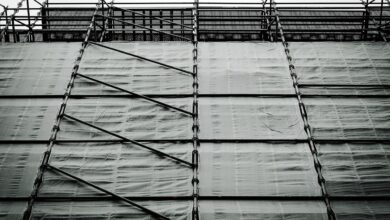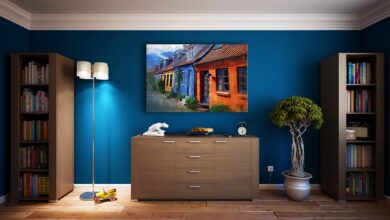How are The Walls Decorated: Decor Ideas, Housing Aesthetics

Decorating the walls of a space is an art form that transcends mere aesthetics, reflecting the essence and personality of the inhabitants. The manner in which walls are adorned not only serves as a visual feast for the eyes but also communicates a narrative, creating an atmosphere that resonates with the occupants. In exploring the diverse realms of wall decor, one unravels a world where creativity intertwines with personal expression, making the walls not just a boundary but a canvas that breathes life into the surrounding environment.
Wall Decorations in The United States
Wall decorations in the United States encompass a diverse array of artistic expressions that reflect the country’s rich cultural tapestry. From traditional paintings and photographs to contemporary murals and digital art installations, the American penchant for decorating walls transcends time periods and geographical boundaries.
Historical Significance: Throughout American history, wall decorations have played a pivotal role in conveying cultural, social, and political narratives. From the murals of the Works Progress Administration (WPA) during the Great Depression to the iconic street art movements in cities like New York, these creations serve as visual chronicles of the nation’s evolving identity.
Traditional Art Forms: Classical forms of wall decorations in the U.S. include oil paintings, tapestries, and framed photographs. These timeless pieces often grace the walls of museums, galleries, and private residences, representing a blend of indigenous cultures, immigrant influences, and artistic innovation.
Contemporary Trends: In recent years, there has been a surge in contemporary wall decorations, reflecting the fusion of traditional and modern aesthetics. Street art, graffiti, and mural festivals have become prevalent, transforming urban landscapes and fostering a sense of community engagement with art. Moreover, digital art projections and interactive installations contribute to the evolving nature of wall decorations.
Cultural Diversity: The diversity of wall decorations in the United States mirrors the nation’s multicultural fabric. African American, Hispanic, Native American, and immigrant communities have all contributed distinct artistic styles, themes, and symbolism to the vast mosaic of American wall art.
Commercial Impact: Beyond artistic expression, wall decorations have become a lucrative industry in the U.S. Interior designers, art consultants, and home decor businesses thrive on curating and providing diverse wall art options to cater to individual tastes and design preferences.
Interior Design Trends in America
Interior design trends in America continually evolve, reflecting the shifting preferences and lifestyles of its diverse population. In recent years, several key trends have emerged, influencing the aesthetics and functionality of residential and commercial spaces.
| Trend | Description |
|---|---|
| Biophilic Design | Incorporating natural elements, such as plants and natural light, to create a connection with nature. |
| Multifunctional Spaces | Designing versatile spaces that serve multiple purposes, adapting to the dynamic needs of residents. |
| Sustainable Materials | Growing emphasis on eco-friendly and sustainable materials, promoting environmental consciousness. |
| Smart Home Integration | Integration of smart technologies for enhanced convenience and control over various aspects of the home. |
| Color Palette Shifts | Shift towards neutral tones and earthy colors, promoting a sense of tranquility and timeless elegance. |
| Vintage and Retro Vibes | Incorporating vintage and retro elements, blending the past with modern design for a unique aesthetic. |
| Inclusive Design | Designing spaces that cater to diverse abilities and lifestyles, promoting accessibility and inclusivity. |
| Customization | Increased demand for personalized spaces, with a focus on custom furniture and unique design solutions. |
Popular Wall Art Styles in The U.S.
In the United States, wall art serves as a powerful means of self-expression and interior decoration. Various styles have gained popularity over the years, reflecting diverse tastes and preferences.
- Abstract Art: Abstract art captivates many with its non-representational and unconventional forms. Artists use color, shape, and gesture to evoke emotions and stimulate the viewer’s imagination. Popular abstract artists like Jackson Pollock and Mark Rothko have left a lasting impact on this dynamic style.
- Minimalism: Minimalist wall art emphasizes simplicity and clean lines, often featuring neutral colors and a reductionist approach. This style resonates with those who appreciate a clutter-free and serene living space. Minimalist art can range from geometric shapes to subtle patterns.
- Contemporary Photography: Contemporary photography has become a staple in modern homes, offering a diverse range of subjects and styles. From striking landscapes to intimate portraits, photography allows individuals to bring a personal touch to their spaces. Black and white photography remains timeless, while vibrant color schemes add a modern flair.
- Pop Art: Originating in the 1950s, Pop Art remains a vibrant and iconic style in the U.S. This movement celebrates popular culture and mass media, incorporating bold colors and recognizable imagery. Artists like Andy Warhol and Roy Lichtenstein have played pivotal roles in popularizing Pop Art.
- Nature-Inspired Art: Many individuals seek solace in nature-inspired wall art, bringing the outdoors inside. Scenes of landscapes, botanical prints, and wildlife illustrations resonate with those who wish to create a calming and natural ambiance within their homes.
- Typography and Quotes: Typography-based wall art has gained popularity, featuring inspirational quotes, witty phrases, and meaningful words. This style allows individuals to personalize their spaces with messages that resonate with them, creating a motivational and visually appealing atmosphere.
Home Decor Ideas For Walls
| Idea | Description |
|---|---|
| 1. Gallery Wall | Create a visually stunning display by arranging a mix of framed photos, art pieces, and mirrors in a gallery-style layout. Choose a cohesive theme or color scheme for a harmonious look. |
| 2. Accent Wallpaper | Elevate a specific wall with bold and stylish wallpaper to add depth and character. Opt for patterns or textures that complement your overall interior design. |
| 3. Floating Shelves | Install floating shelves to showcase decorative items, books, or small plants. Experiment with different arrangements to achieve a personalized and functional display. |
| 4. Mirrors for Depth | Use mirrors strategically to create an illusion of space and enhance natural light. Choose decorative frames that match your decor style for an added aesthetic touch. |
| 5. DIY Wall Art | Unleash your creativity by crafting your own wall art. Explore painting, fabric wall hangings, or even repurposing everyday items into unique and personalized decor pieces. |
| 6. Green Wall or Planters | Bring nature indoors by incorporating vertical gardens or hanging planters. Not only do they add a touch of greenery, but they also contribute to a refreshing ambiance. |
| 7. Statement Clocks | Select a statement clock that serves both functional and decorative purposes. Opt for oversized or uniquely designed clocks that become a focal point on your wall. |
| 8. Typography and Quotes | Express your personality through inspirational quotes or typography art. Choose fonts and styles that resonate with your overall design theme and message. |
Enhance the visual appeal of your home by implementing these creative and stylish wall decor ideas. Tailor each suggestion to align with your personal taste, creating a space that reflects your unique style and preferences.
American Housing Aesthetics
American housing aesthetics reflect a rich tapestry of architectural styles and design preferences that have evolved over centuries. From historic colonial influences to modern innovations, the diverse landscape of American homes showcases a unique blend of tradition and contemporary trends.
Colonial Roots: The early American housing aesthetic draws inspiration from European colonial styles, characterized by symmetrical designs, steep roofs, and simple facades. Georgian and Federal styles, prominent in the 18th and 19th centuries, exhibit a sense of classical elegance with features like evenly spaced windows and grand entrances.
Victorian Extravagance: The Victorian era introduced a departure from the simplicity of colonial designs. Characterized by ornate detailing, vibrant colors, and asymmetrical facades, Victorian homes are known for their eclectic and extravagant aesthetic. Towers, turrets, and decorative elements define this period’s architecture.
Craftsman Charm: In the early 20th century, the Craftsman style emerged as a reaction against the ornate Victorian designs. Focused on simplicity, craftsmanship, and natural materials, Craftsman homes feature overhanging eaves, exposed rafters, and front porches, emphasizing a connection with nature and artisanal values.
Mid-Century Modernism: Post-World War II, mid-century modernism gained popularity, emphasizing functionality, open spaces, and integration with nature. Clean lines, flat planes, and large windows characterize this style, reflecting a departure from the ornate and embracing a more minimalist approach.
Suburban Sprawl: The post-World War II era also witnessed the rise of suburban housing, marked by ranch-style homes. Single-story structures with open floor plans and a focus on informal living defined this period. These homes often feature attached garages and expansive lawns, embodying the American dream of homeownership.
Contemporary Trends: In recent decades, American housing aesthetics have embraced a variety of styles, from neo-traditional designs to sustainable architecture. Contemporary homes often prioritize energy efficiency, smart home technology, and adaptable living spaces to meet the evolving needs of homeowners.





The walls are adorned with an eclectic mix of modern art and vintage photographs, creating a visually stunning and thought-provoking ambiance.